Binance Smart Chain is known for having high throughput, the chain uses a Proof of Staked Authority consensus. BSC is EVM-compatible and offers very low fees. The chain is also very much focused on ecosystem growth, supported by Binance and its massive treasury.
The Future Is Modular

Key takeaways
- We predict that the combination of the Ethereum blockchain and Layer 2 solutions will be the preferred option for both users and people willing to build Web3 projects.
- This tandem has the potential to solve the two critical struggles Layer 1s are facing: the lack of network effects and the inability to solve the blockchain trilemma (or tetralemma, as stated in the report).
- The speed of app development, and the growing interest of VCs, indicate a bright future for Layer 2s in general. And the higher the network effects in this category, the fewer resources for alternative Layer 1s to compete with Ethereum.
- Layer 2s appear to improve the business model of blockchains as well. As of now, basically, no Layer 1 except for Ethereum is and can become profitable. The introduction of, and app development on Layer 2s can finally increase the popularity of non-speculative revenue streams in Web3. We explore the example of friend.tech and Base L2, and also the general financial condition of all major Layer 2s.
- It’s important to bear in mind that Layer 2s still face significant challenges, including a high level of centralization, problems with UX, or still constrained scalability. However, as they’re much better conceptualized and designed than Layer 1s coming from earlier stages of blockchain development, they can successfully address these struggles in the near future.
How alternative L1s planned to challenge Ethereum?
$ 34.7 B
market cap
Sources: Messari, DappRadar, TokenTerminal
$ 25.7 B
market cap
Challenges Ethereum by having high throughput, low transaction costs, and fast processing speed, It leverages a Proof of History consensus combined with PoS for efficient and scalable blockchain performance.
Sources: Messari, DappRadar, TokenTerminal
$ 13.5 B
market cap
Offering a more scalable, energy-efficient, and secure blockchain platform through its Ouroboros PoS algorithm and a focus on research-driven development.
Sources: Messari, DappRadar, TokenTerminal
$ 7.7 B
market cap
Offering higher transaction throughput, rapid finality, and lower fees. Using the Avalanche Consensus Protocol consensus allows for a more scalable and customizable blockchain creation (thanks to subnets).
Sources: Messari, DappRadar, TokenTerminal
$ 6.7 B
market cap
Focusing on providing interoperability within its ecosystem as well as a higher level of independence for chains connected to its mainchain.
Sources: Messari, DappRadar, TokenTerminal
$ 3.5 B
market cap
Using Tendermint's consensus algorithm, and IBC to communicate interoperable between the different blockchains in the network. It’s designed to scale horizontally and leave as much independence to its app-specific blockchains as possible.
Sources: Messari, DappRadar, TokenTerminal
Ethereum keeps running high, but naturally is not without issues. Its blockchain struggles with scalability, users lament the slow transaction speed and very high costs. In fact, the costs are incomparable with both other Layer 1s and non-blockchain solutions. Moreover, after the transition to PoS (Proof of Stake) consensus, concerns over Ethereum’s real decentralization are becoming loud.
Does this mean, as blockchain users and builders, who are forced to rely on Layer 1s, are we facing a tragic conflict? Before we answer this, let’s dig deeper into the two main struggles Layer 1s are up against in 2023 and beyond. In this first part of our report, we will provide you with a thorough understanding of the intricacies of the challenges, how they interact and affect each other, and what we can conclude from this analysis.
Ethereum’s task at hand is to solve the blockchain trilemma.
Alternative Layer 1s need to generate and benefit from network effects.
What is the blockchain trilemma, and why is it unsolvable?
Blockchain networks are designed with specific goals and priorities. The various design choices are based on the intended use cases of the specific blockchain project and typically involve trade-offs.
The concept of the scalability trilemma was formed in response to the challenges faced by different blockchain projects when trying to balance between: decentralization, security, and scalability.
The trilemma claims that blockchain systems can only have at most two of the following three properties:
Scalability
As blockchains inevitably grow, they need to handle an increasing number of transactions and users without sacrificing performance. A scalable blockchain is designed to process a higher throughput of transactions efficiently
Security
Data and network security are crucial for the integrity of a blockchain network. It involves protection against various attacks, such as double-spending or unauthorized changes to the blockchain. A secure blockchain ensures the integrity and immutability of the data it stores.
Decentralization
The concept of decentralization is in the heart of blockchain technology. Distribution of control and decision-making across a network of participants eliminates the need for a central authority.
You cannot achieve higher scalability without compromising on security and decentralization. To improve security, you need to inhibit scalability, and to maintain full decentralization you restrict scalability.
This need for trade-offs hinders the widespread adoption of blockchain technology and has held back the growth and adoption of basically all the Layer 1 blockchains. For example, Ethereum struggles the most with the “scalability” aspect. As a result, transactions processed through this blockchain are much slower and more expensive than on other, less secure, and less decentralized Layer 1s. You can find the TPS (Transaction per Second) for major Layer 1s in the following chart.
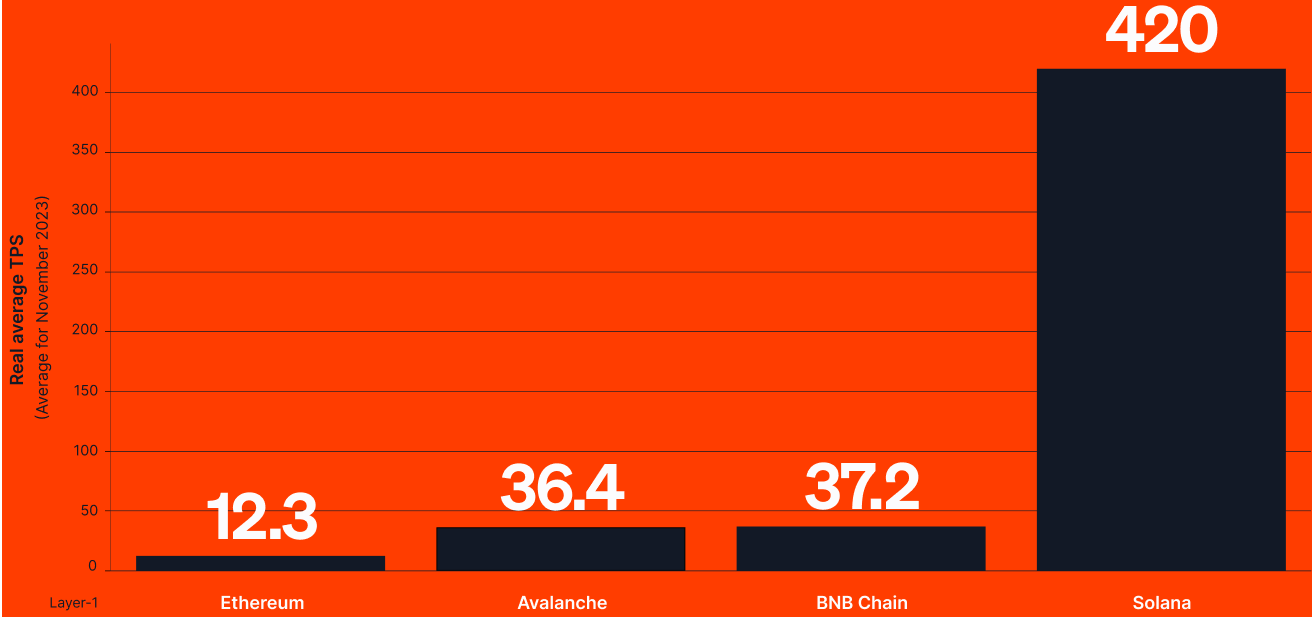
Source: Dune Analytics (@k06a, @robin_y)
However, let’s put Ethereum aside and look at how these numbers compare to the average 1,500-2,000 transactions per second conducted by payment processor VISA. Or a maximum of 65,000 TPS that it can arguably handle. None of the numbers compete.
Moreover, the TPS numbers (as well as TVL) are often inflated and sometimes generated and boosted by internal microtransactions. A good example is Solana, where approximately 80% of transactions are made up of its own consensus messages. We analyzed the real average TPS based on actual charts, not declarations made by protocols. Let’s add another metric that highlights the scalability issues of all blockchains: swaps per second (conceptualized by consumer insights agency Dragonfly Capital). This metric applies to the factual transactions made by Layer 1 users, rather than internal transfers between validators. You can find more on this methodology in a recent article by CoinTelegraph and a comparison of swaps per speed in the table below.
Source: Dragonfly Capital
Again, when we compare these numbers to VISA as a benchmark for discussing Layer 1s’ speeds, we see that these scalability issues are not limited to Ethereum anymore. Also, not only TPS should be improved – especially because boosting it “no matter what” can impede scalability – but from a user point of view the cost of blockchain operations is even more crucial.
Consequently, we need to add one more element to the blockchain trilemma, turning it into a “tetralemma” (“tetra”, from Greek, meaning “four”). Scalability, decentralization, and security issues affect also the business aspects of running a blockchain, leaving us with the question of whether Ethereum (or any other Layer 1) can maintain these 3 important traits, and be profitable (the fourth part) at the same time.
Exploring the blockchain tetralemma
The typical business model of a blockchain is clear: selling block space in exchange for fees. The more block space is sold, the more money gets poured into the protocol. And, as blockchains remain decentralized protocols, these assets are redistributed to network participants or burned to reduce the inflation of the token representing a particular chain.
However, the blockchain trilemma discussion shows that the most decentralized chains also face the highest risk of being unscalable. Ethereum, the biggest one in terms of transactions, TVL (Total Value Locked), and generated revenues is a perfect example.
Ethereum leads the way in terms of network effects for both users and developers. They benefit from the vast ecosystem of apps and the variety of options but, at the same time, struggle with high fees and low throughput. In short, the more activity, the higher the fees.
To illustrate this point, here are some numbers:
1.03
The average gas price in November 2023 (based on Etherescan
2.99
The more realistic median price for 2023
13.88
In times of higher congestion, i.e. May 2023, the daily median was as high as $13.88.
30
During times of a bull market, i.e. in 2021, the median price per transaction exceeded $30.
Why Layer 1s are lacking business sustainability
Assuming Ethereum may be compromised by its own inefficient infrastructure, why don’t we see alternative Layer 1s as a valuable option from a business perspective? The short answer is: Layer 1 blockchains practically can’t become profitable.
Ethereum continues to dominate the revenue and earning categories among Layer 1s, despite the challenges. Besides TRON, the main blockchain for USDT which generates most of its revenue from stablecoin transactions, no Layer 1 comes close to Ethereum when we discuss business.
Following is a revenue comparison chart.
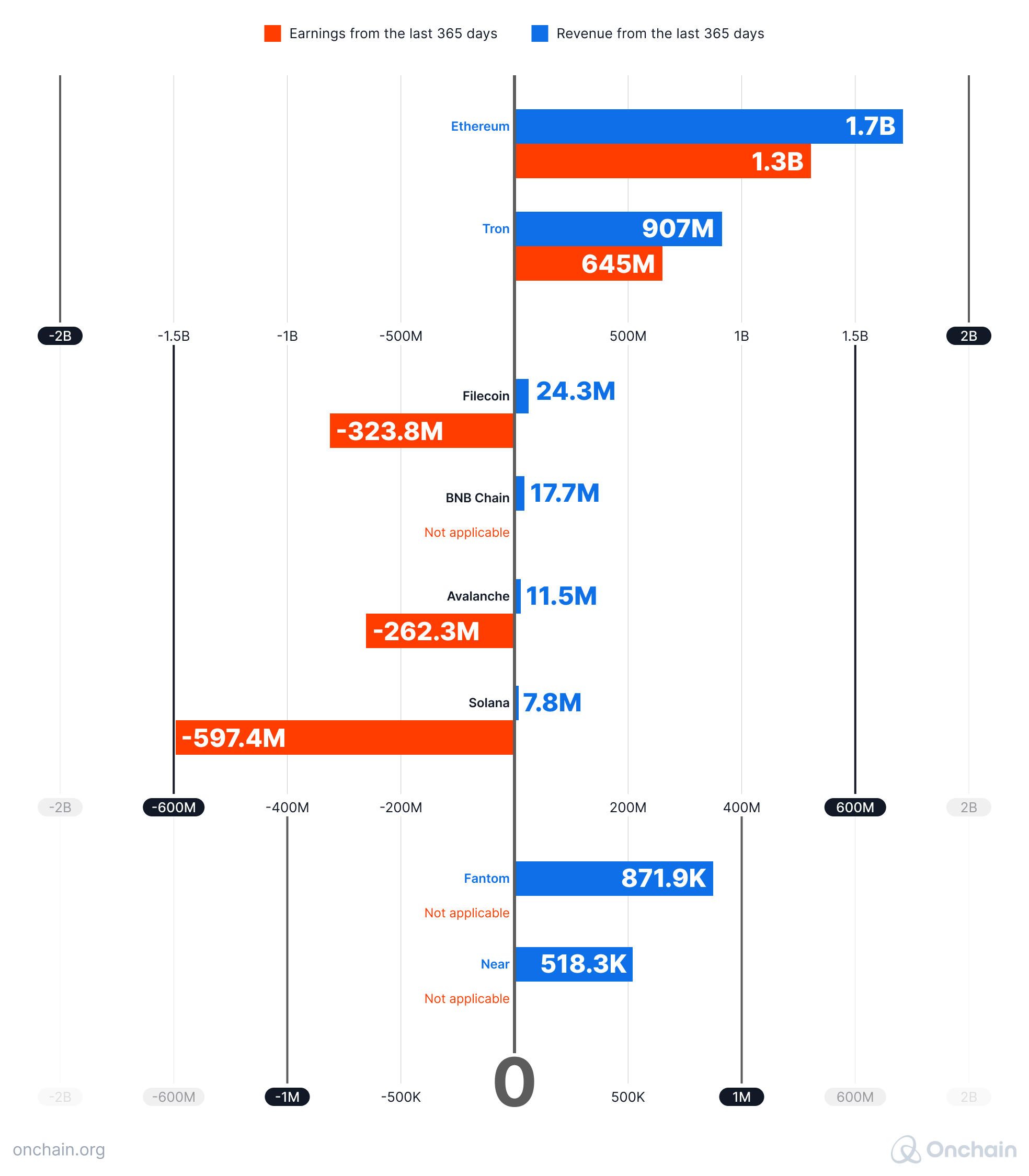
A comparison of the revenues and earning across the major L1s
The numbers speak for themselves. Ethereum’s revenue is twice as high as that of the second in line, TRON, while the third achieves less than 2% of Ethereum’s revenue with negative earnings.
Moreover, we don’t know what the real costs of maintaining the companies and foundations behind these protocols are. Even a part of $1.3B earnings that is captured by Ethereum’s Foundation should be enough to pay salaries for their members as well as cover costs related to grants and other incentives. Their latest financial statement is from April 2022 and states $48M of spendings in 2021. Even if this number increases in the future – which can be expected – Ethereum still remains profitable, when investigated like any traditional company; in fact, very profitable. This can’t be said about many other Layer 1s.
And there is more to consider besides the pure revenues of the protocol. In the sections below, we analyze the number of dApps built per blockchain. One figure stands out among the crowd: 5,071 applications created on BNB. The number tops even Ethereum’s impressive 4,385. However, when we compare the revenues generated by dApps built on these blockchains, Ethereum has a clear upper hand, no matter what blockchain we’d pick for comparison.
Moreover, despite the higher number of unique active wallets (542.4M on BNB vs. 146.8M on Ethereum) and the general number of transactions (1.44B vs. 0.19M), BNB is far from Ethereum’s earnings.
Behind the numbers
The main explanation for these numbers is rooted in the aforementioned business model of blockchains. Alternative Layer 1s sell their blockspace at a price that is too low for them to become profitable in the long term.
Fees are so small that these chains need to either
- raise the incentives for the network participants, which increases the inflation and general costs for the protocol, or
- raise the fees to generate more earnings.
What if they got rid of any of their substantial attributes like low costs and high throughput?
Even in the current state, these advantages are not enough to provide alternative Layer 1s with a competitive advantage in the battle over user acquisition against Ethereum. Despite a significant number of transactions and very inviting costs, nearly all Layer 1s are lacking adoption and interest compared to the more expensive and allegedly non-scalable Ethereum.
The only exception is BNB. On the downside, this blockchain is more centralized than the others described, which brings us back to the trilemma and the question of the tetralemma.
Can a blockchain become sustainable without compromising scalability and centralization at all?
Before we provide you with a data-driven answer, we need to explore the second major struggle of blockchains – this time mainly for alternative Layer 1s: network effects.

Network effects - telecommunication example
How network effects impact Web3
- Web3 is specifically dependent on network effects:
- They enable a higher speed of development in its still infancy stage.
- They provide an essential utility for dApps.
- They help to make blockchains secure and decentralized.
- They lead to the creation of diverse and vibrant ecosystems.
- They enable community growth and, in consequence, its support (in both protocols’ marketing and development).
Contrary to the blockchain trilemma, with which all Layer 1s struggle, the network effects are particularly troublesome for the Ethereum competition, meaning all Layer 1s except Ethereum. The following table includes figures that highlight this conclusion.
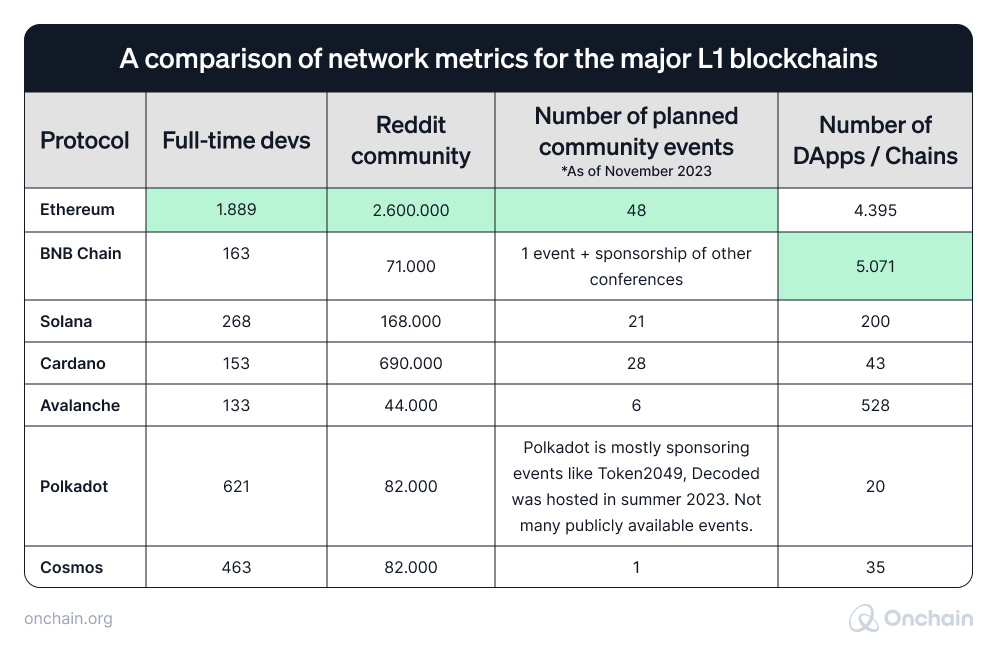
Sources: Developer Report, DappRadar, L1s’ websites, and social media accounts
The number of full-time developers and the general size of the community help Ethereum capitalize on Metcalfe’s Law and thereby increase its network effects. It’s especially important regarding the speed of development of high-quality dApps. More developers mean more innovation, a broader range of applications, and quicker problem-solving.
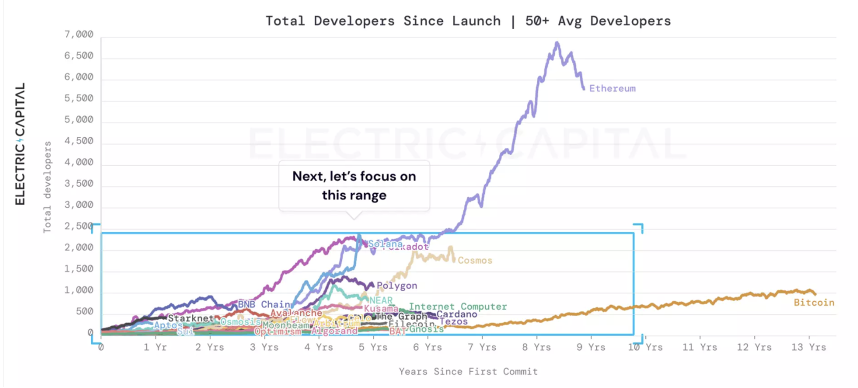
Source: Electric Capital
The above graph shows the extent to which the number of developers functions as a catalyst for the Ethereum ecosystem growth. We must also keep in mind that the overall number of Web3 developers in the world is still limited and inhibits the progress potential of other Layer 1s.
Here is an overview of the primary network-effect-related challenges Layer 1s faced in 2023.
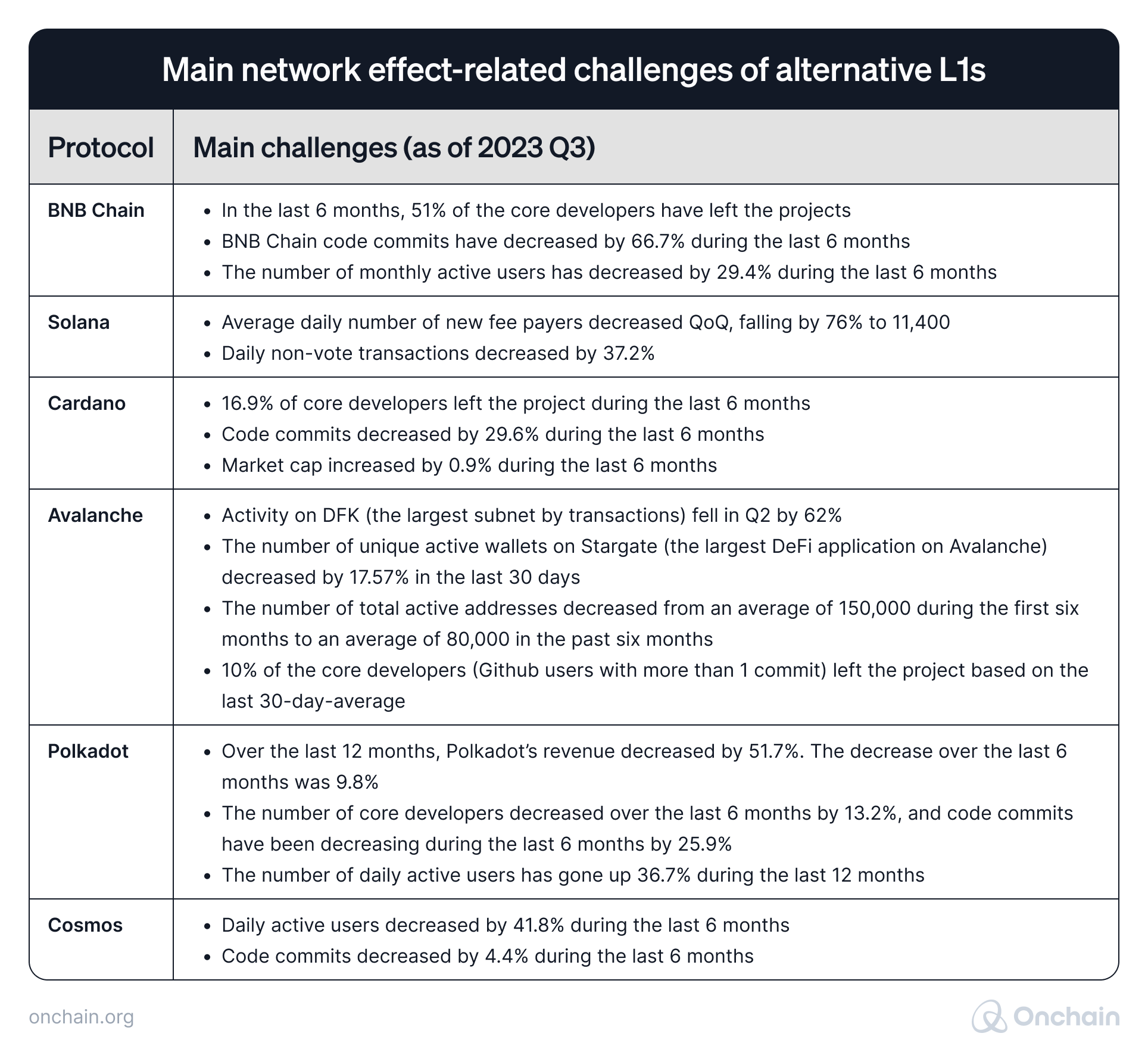
Sources: Messari, DappRadar, TokenTerminal
Additional factors contributing to Ethereum’s massive network effects
- Widespread adoption of standards – Ethereum introduced standards like ERC-20 and ERC-721, which have become widely adopted across the industry.
- Dominance in DeFi and NFTs – making Ethereum the primary ecosystem not only for developers but most importantly, for individuals.
- High liquidity and trading volume – improving the user experience of the ecosystem and holding on to users despite the struggles with the blockchain trilemma/tetralemma.
- Recognized brand and trust – after the last bull run of 2021-2022, it is hard for anyone to imagine the future of blockchain without Ethereum. The protocol established itself as the foundation of the industry and maintained its status, despite the massive growth of its competitors during this period. The network continues to attract more developers and users.
These network effects become most obvious to an individual when looking at the number of dApps built on Ethereum and other ecosystems. The graph below compares pure TVL (Total Value Locked) in various applications. As you can see, Ethereum dominates across all timeframes, with a 60-75% market share maintained over the last 2 years.

Source: Dune Analytics (@cryptokoryo)
These findings are backed by the general activity in dApps. The below displayed table shows that, compared to the BNB chain, Ethereum counts a lower number of unique wallets and applications built. On the other hand, the value generated from these apps and their NFT volume are remarkably higher on Ethereum. We can assume that it’s the only Layer 1 where dApps and users interacting with them are genuinely active and not artificially inflated.
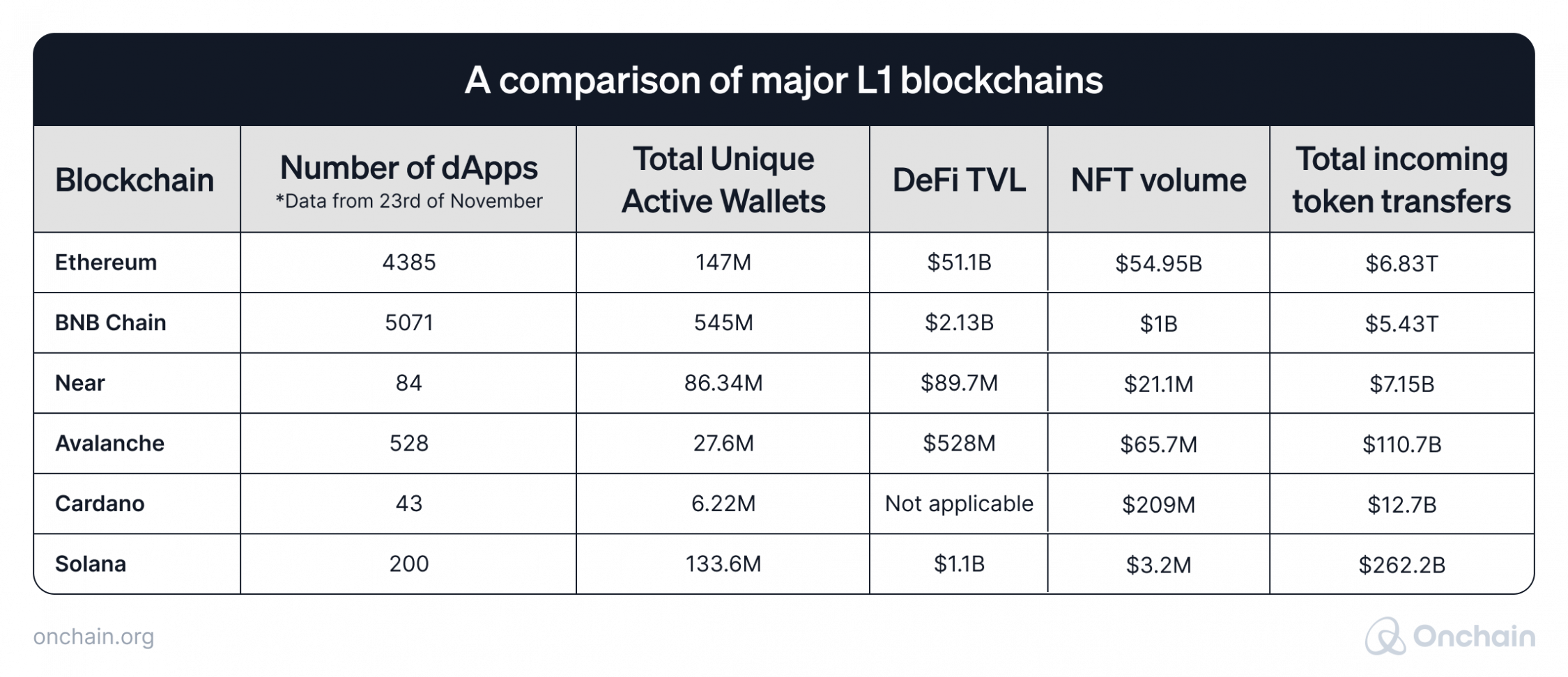
Source: DappRadar
Note that the numbers above refer only to the Ethereum Mainnet. If we added its scaling solutions (more on that in the following sections), such as Polygon, Arbitrum, Optimism, zkSync, or Base, the results would look as shown in the following table:

Source: DappRadar
Ethereum’s dominant position becomes even more evident when we look at individual categories of Web3 projects. It leads across the board DEXs, NFTs and RWAs.
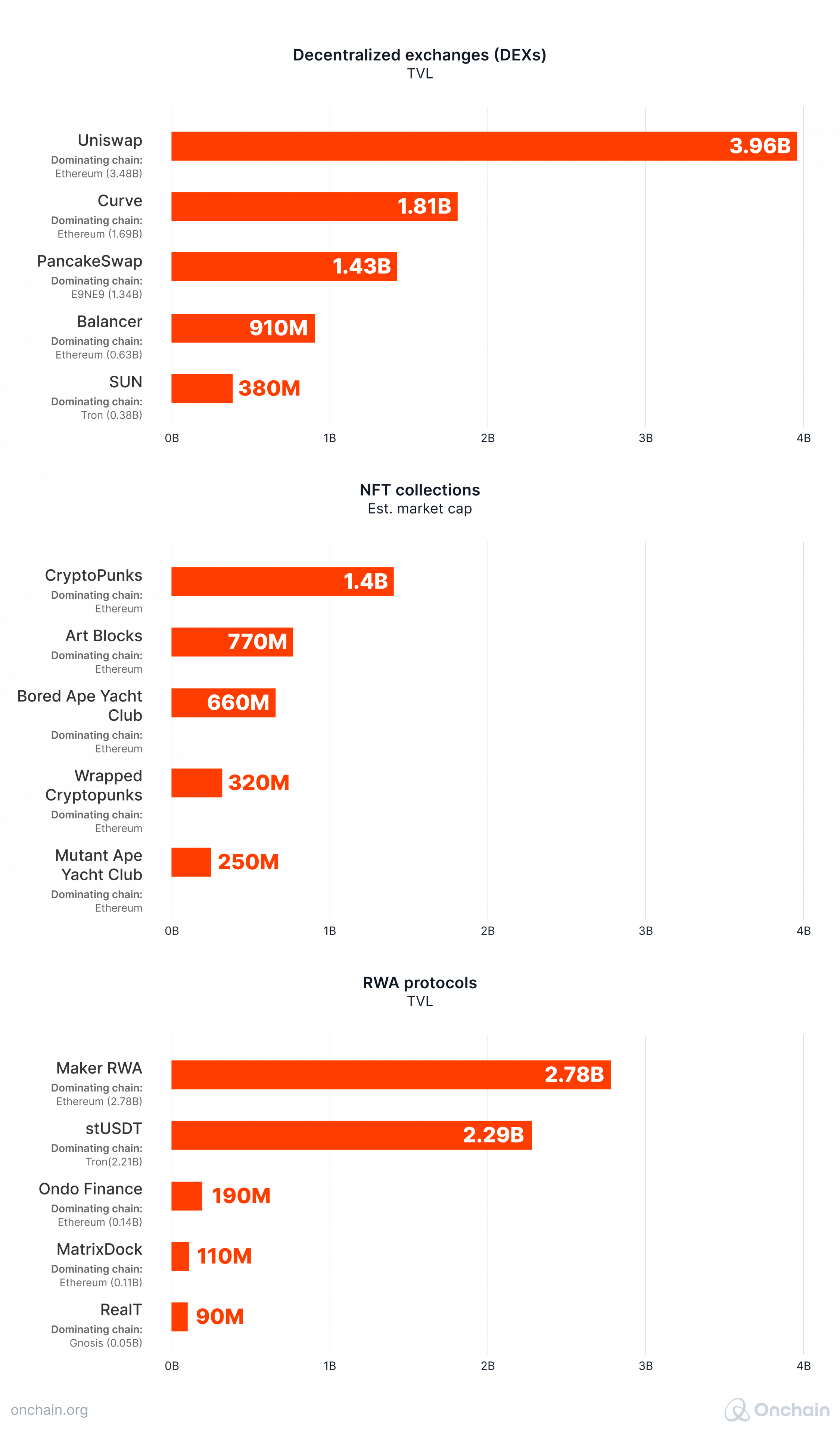
Sources: DefiLlama, CoinMarketCap
To sum it up, these factors lead to the conclusion that Ethereum spearheads the Layer 1 landscape:
- sustainability and potential profitability of the protocol
- network effects within the ecosystem
- dominance in the DeFi and NFT areas
- over 60% of the market’s total value is locked in the protocol
One critical question remains: Are they enough to ensure long-term success, if Ethereum doesn’t solve its scalability issues?
In the second part of this paper, we will focus on technological advancements aimed at tackling the major struggles of Layer 1s laid out in the first section. We examine if they can solve the blockchain tetralemma while capitalizing on existing network effects, which would bring the much awaited technical Web3 readiness for mass adoption.
This content is accessible only
to members.
if you are a member.
Led by
-

Michał Moneta
Leader & Chief Strategy Officer
Conducted by
-

Ananya Shrivastava
Research Analyst
-

Boris Agatić
Data Scientist
-

Arin Soleymani
Head of Business Development
Contributors
-

Ruth M. Trucks
Head of Content
-

Lucas De Melo
UX Designer